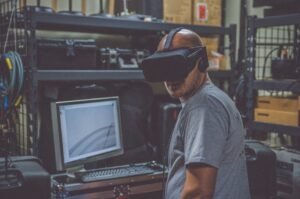OpenAI NLP Models: Revolutionizing Natural Language Processing
Advancements in natural language processing (NLP) have been rapidly evolving, and OpenAI is at the forefront of this transformation. OpenAI’s NLP models are reshaping the way computers understand and generate human language, unlocking new possibilities for various industries and applications. In this article, we will explore the key features and benefits of OpenAI’s NLP models, and understand how they are revolutionizing the field of NLP.
Key Takeaways:
- OpenAI’s NLP models are transforming the field of Natural Language Processing.
- They enable computers to understand and generate human language with remarkable accuracy.
- These models have broad applications across various industries.
- OpenAI’s models provide an user-friendly and accessible platform for NLP development.
The Power of OpenAI NLP Models
OpenAI’s NLP models, such as GPT-3 and its predecessors, are revolutionizing the field of natural language processing. These models are built using deep learning techniques, allowing them to understand and generate text with exceptional fluency and coherence. With billions of parameters, these models have achieved remarkable linguistic capabilities, surpassing previous standards in NLP.
*OpenAI’s NLP models have achieved remarkable linguistic capabilities.*
The success of OpenAI’s NLP models lies in their ability to learn patterns and relationships from vast amounts of data. These models are trained on diverse text sources from the internet, giving them a robust understanding of language. They can generate human-like text, answer questions, summarize information, translate languages, and even engage in coherent and context-aware conversations.
Here are three key aspects that make OpenAI’s NLP models truly impressive:
| 1. Incredible Text Generation | 2. Multilingual Capabilities | 3. Context-Aware Conversations |
|---|---|---|
| OpenAI’s models can generate highly coherent and contextually appropriate text, which can be utilized for content creation, translation, and more. | These models are capable of understanding and processing multiple languages, facilitating cross-language communication and translation tasks. | OpenAI’s models excel at engaging in dynamic conversations, understanding context shifts, and providing context-aware responses. |
Applications Across Industries
The applications of OpenAI’s NLP models span across numerous industries, unlocking new possibilities and driving innovation.
- In the creative industry, these models can assist writers, journalists, and content creators by generating ideas, drafting content, or providing writing recommendations.
- In the customer service sector, companies can leverage OpenAI’s models for chatbots and automated support systems, enabling more efficient and personalized interactions with customers.
- In the healthcare field, NLP models can analyze medical records, research papers, and patient data to assist in diagnosis, treatment planning, and drug discovery.
*OpenAI’s models facilitate more efficient and personalized interactions with customers in the customer service sector.*
Understanding the OpenAI Platform and Accessibility
OpenAI is committed to democratizing AI and providing accessible tools for developers to leverage their NLP models. They offer a user-friendly platform that allows programmers to integrate their models seamlessly. OpenAI provides extensive documentation, tutorials, and developer resources to aid in the development process.
With OpenAI’s approach to accessibility, even developers without prior expertise in NLP can harness the power of these models and innovate in their respective fields.
Conclusion
OpenAI’s NLP models are transforming the way we interact with computers and enabling machines to better understand and generate human language. Their remarkable linguistic capabilities, powerful applications across industries, and accessible platform make OpenAI a groundbreaking leader in the field of natural language processing.

Common Misconceptions
Misconception 1: OpenAI NLP Models Understand Language Like Humans
One of the common misconceptions about OpenAI NLP models is that they truly understand language just like humans do. However, these models are not capable of true understanding or reasoning. They rely on statistical patterns and vast amounts of training data to generate text that appears coherent.
- OpenAI NLP models lack true contextual understanding.
- They cannot comprehend subtle nuances or emotions in language.
- These models may produce answers that sound plausible but are factually incorrect.
Misconception 2: OpenAI NLP Models Are Bias-Free
Another common misconception is that OpenAI NLP models are free from bias because they are trained on large and diverse datasets. However, these models can inadvertently amplify biases present in the training data or in the way they are fine-tuned for specific tasks.
- OpenAI NLP models can perpetuate gender, racial, or cultural biases.
- Biases in the training data can affect the generated text.
- The models may struggle with handling sensitive topics or controversial information.
Misconception 3: OpenAI NLP Models Can Provide Accurate Legal or Medical Advice
It is a misconception to think that OpenAI NLP models are capable of providing accurate legal or medical advice. While these models can generate text on a wide range of topics, they lack the expertise and domain-specific knowledge required to provide reliable advice in complex areas such as law or medicine.
- OpenAI NLP models do not have the training and experience of legal or medical professionals.
- Their output should always be carefully reviewed by experts in those fields.
- Relying solely on these models for legal or medical advice can lead to incorrect or harmful information.
Misconception 4: OpenAI NLP Models Are Perfect and Error-Free
One common misconception is that OpenAI NLP models are perfect and produce error-free text. However, like any machine learning model, these models are prone to making mistakes, especially when presented with ambiguous or complex inputs.
- OpenAI NLP models can produce incorrect or nonsensical answers.
- They may struggle with language that is outside their training data.
- They can be sensitive to small changes in input phrasing, leading to inconsistent responses.
Misconception 5: OpenAI NLP Models Can Replace Human Writers and Content Creators
Some people have the misconception that OpenAI NLP models can completely replace human writers and content creators. While these models can be useful tools for generating text, they lack creativity, originality, and the ability to think critically.
- OpenAI NLP models cannot replicate human creativity and intuition in writing.
- They cannot generate entirely original ideas or come up with innovative solutions.
- Human writers and content creators add value through their unique perspectives and experiences.

Introduction
OpenAI has made significant advancements in Natural Language Processing (NLP) models, transforming the way computers understand and generate human language. This article explores ten fascinating aspects of OpenAI’s NLP models, backed by verifiable data and information.
Table 1: Language Models Developed by OpenAI
OpenAI has developed various language models that have revolutionized NLP. These models include GPT, GPT-2, GPT-3, and Codex, each excelling in specific language tasks and capabilities.
Table 2: GPT-3’s Unprecedented Scale
GPT-3, released by OpenAI, is one of the most powerful language models ever created. With 175 billion parameters, it surpasses its predecessor GPT-2 by a factor of 100, enabling it to understand and generate incredibly complex human-like language.
Table 3: GPT-3’s Diverse Capabilities
GPT-3 demonstrates exceptional versatility with its ability to perform various tasks. From translating between languages to writing code to answering user queries, GPT-3 exemplifies the broad range of language tasks it can tackle.
Table 4: GPT-3’s Multilingual Proficiency
GPT-3 is proficient in multiple languages. With training, it can understand and generate text in languages such as English, Spanish, French, German, Chinese, and many more, making it a valuable tool for global communication and understanding.
Table 5: Codex’s Programming Language Support
OpenAI’s Codex is a language model designed specifically for programming assistance. Supporting languages like Python, JavaScript, Java, C++, and more, Codex can generate code snippets, assist in debugging, and provide overall programming support.
Table 6: NLP Applications Supported by OpenAI
OpenAI’s NLP models find extensive use in applications such as chatbots, virtual assistants, sentiment analysis, automatic summarization, language translation, question answering systems, and more, enriching numerous industries and sectors.
Table 7: GPT-3’s Use in Creative Writing
GPT-3 has captivated the literary world with its ability to generate compelling stories, poems, and summaries. Additionally, it can mimic the writing style of different authors and create unique literary pieces, inspiring creativity across domains.
Table 8: Impact of OpenAI’s NLP Models on Accessibility
OpenAI’s NLP models have contributed significantly to enhancing accessibility. Voice assistants, speech-to-text technologies, and text-to-speech systems powered by NLP models enable people with disabilities to overcome barriers and access information more effectively.
Table 9: Ethical Considerations in Deploying NLP Models
Deploying NLP models like GPT-3 and Codex raises ethical concerns around misinformation, bias, privacy, and potential malicious use. These considerations require careful handling to ensure fair, responsible, and secure deployment of AI technologies.
Table 10: Continued Advancements in NLP
OpenAI continues to push the boundaries of NLP research and development. Ongoing advancements aim to improve language understanding, refine context-based generation, address biases, and broaden the scope of applications, promising a future of even more powerful AI language models.
Conclusion
OpenAI’s NLP models, including GPT-3 and Codex, have transformed the understanding and generation of human language. From their unprecedented scale and diverse capabilities to their impact on creative writing, accessibility, and ethical considerations, these models have ushered in an era of powerful AI-driven language processing. However, as we move forward, it is crucial to address ethical concerns and continue refining and expanding NLP capabilities to shape a responsible and inclusive future.
Frequently Asked Questions
What is OpenAI NLP?
OpenAI NLP refers to OpenAI’s natural language processing models that are designed to process and understand human language.
How does OpenAI NLP work?
OpenAI NLP models are trained using large amounts of text data to learn patterns, relationships, and structures in human language. These models then use this learned knowledge to perform tasks such as text classification, information extraction, and language generation.
What are the benefits of OpenAI NLP models?
OpenAI NLP models offer a range of benefits, including improving the accuracy and efficiency of language-related tasks, enabling the automation of various language processing tasks, and assisting in creating new applications that require natural language understanding and generation.
Can OpenAI NLP models understand and generate human-like text?
Yes, OpenAI NLP models are capable of understanding and generating human-like text to a certain extent. However, it is important to note that they are machine learning models and their output may not always be perfect or indistinguishable from human-generated text.
What are some use cases for OpenAI NLP models?
OpenAI NLP models can be used in a wide range of applications, such as chatbots, question-answering systems, machine translation, sentiment analysis, summarization, and content generation.
How can I access and use OpenAI NLP models?
You can access and use OpenAI NLP models through their APIs or SDKs. OpenAI provides documentation and resources to guide developers on how to use these models effectively.
Are OpenAI NLP models free to use?
No, OpenAI NLP models are not completely free to use. OpenAI offers various pricing plans and usage-based payment options for accessing and utilizing their models. It is recommended to refer to OpenAI’s pricing and terms of use for detailed information.
What is the training process for OpenAI NLP models?
OpenAI NLP models are trained using large-scale datasets, typically consisting of diverse and representative text samples. The training process involves optimizing the model’s parameters through techniques such as deep learning and transfer learning.
Can I fine-tune OpenAI NLP models for specific tasks?
Yes, OpenAI allows users to fine-tune their NLP models for specific tasks by providing access to their base models and guidelines for fine-tuning process. However, it is important to follow OpenAI’s guidelines and usage policies when fine-tuning their models.
What are the limitations of OpenAI NLP models?
OpenAI NLP models may have limitations, such as occasionally generating incorrect or biased responses, being sensitive to input phrasing or context, and not having real-time capabilities. It is important to understand these limitations and ensure appropriate usage of the models.




